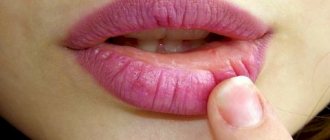How is plaque formed?
Epithelial cells on the surface of the tongue are constantly exposed to fairly aggressive factors: acidic foods, temperature changes, bacteria. That is why their lifespan is not long and after they are exfoliated, young cells appear. If the processes of changing cellular layers are excessively active, then the upper layers do not have time to peel off and remain on the surface of the mucosa in the form of plaque.
Another factor in the formation of plaque can be microorganisms. Children often do not pay enough attention to oral hygiene, as a result of which microscopic particles of food can remain between the lingual papillae, which become a place for active reproduction of bacteria. Taking antibacterial drugs often provokes the growth of pathogenic microflora in the mouth (fungi), some varieties of which are quite brightly colored.
Diagnostics
If a baby has a white spot in the mouth, to make an accurate diagnosis, a number of tests are prescribed, as well as certain procedures. Usually the doctor immediately notices the problem when examining the surface of the mucous membrane. In addition, the following may be additionally prescribed:
- Scrapings or smears from the cheesy film;
- Collecting anamnesis during a conversation with parents;
- Clinical blood test;
Purpose of the study: detection and confirmation of Candida fungi. If necessary, the mother must additionally show the child to specialized doctors. This will help identify the inflammatory processes that occur in the internal organs, which will help prevent serious complications. An oral smear plays an important role in making a correct diagnosis. After drying the applied scraping onto medical glass, staining and examination under a microscope are carried out. Identification of fungal colonies allows the doctor to select the desired therapeutic regimen, taking into account the characteristics of the body and the age of the patient.
Causes of plaque on the tongue
There are many reasons why various plaques may appear on the tongue: from the banal consumption of foods that can change the color of the tongue, to serious health problems that require immediate medical attention.
The very first thing you need to do when you discover strange coatings on a child’s tongue is to remember what the baby ate in the last 24 hours. Very often, sweet carbonated drinks, caramels or other sweets contain active dyes that can give the oral mucosa the most exotic shades: crimson, purple, green, orange and others. Even natural berries and fruits can radically change the color of the tongue. Therefore, there is no need to panic right away. You should ask the child to brush his teeth and tongue, and then evaluate their condition and color. If the plaque has not changed or has reappeared without connection with food intake, then this is a reason to urgently visit your pediatrician.
So, what kind of plaque on a child’s tongue happens, what can cause its appearance and how to treat it, we will consider further.
White
White plaque can be found in the oral cavity of a baby most often. This phenomenon also happens normally when, after a night’s sleep, a thin white coating without an unpleasant odor is found on the tongue, disappearing after hygiene procedures and not causing any discomfort or unpleasant sensations.
The appearance of a dense whitish plaque, which is extremely difficult to remove from the surface of the tongue and does not disappear after brushing your teeth, may indicate problems with the gastrointestinal tract (gastritis, enteritis or dysbacteriosis). This phenomenon is often accompanied by bad breath. In addition, children may present complaints that may indicate gastrointestinal pathology:
- abdominal pain of various localizations;
- bloating;
- stool disorders;
- change in appetite
In order to get rid of such white plaque, it is necessary, first of all, to examine the digestive system and eliminate even the most minor disturbances in its functioning.
In infants up to 2 months of life, thrush or oral candidiasis is a common occurrence in a nursing mother, especially after taking antibiotics or an error in diet. With this pathology, abundant cheesy white deposits appear on the tongue and cheeks, which are easily removed, and small ulcers are found underneath them. After starting treatment for thrush with antifungal agents and treating the oral cavity with antiseptic solutions, the tongue and other mucous membranes quickly cleanse and regain their previous appearance.
Grey
A gray coating on the tongue can be a sign of some infectious diseases. For example, with scarlet fever, on the very first day the mucous membranes become covered with a dirty gray coating, which, starting from the tip of the tongue, gradually disappears and reveals a “raspberry tongue” - enlarged papillae on a bright red background, which is very reminiscent of raspberries.
With diphtheria, gray filmy deposits can be found on the root of the tongue, which are difficult to separate. Such plaques spread to the mucous membranes of the throat, palatine arches and are accompanied by coughing and attacks of suffocation.
Treatment of such infectious diseases is carried out only in a hospital setting. After healing, all plaque on the tongue disappears.
Dehydration in a child can also lead to the formation of a gray coating on the surface of the tongue. At the same time, the mucous membranes look dry and dull. Replenishing the required volume of fluid quickly eliminates this symptom.
Yellow
A dense yellow coating on the tongue indicates pathology of the liver or biliary tract. Often in children, diseases of the biliary system occur without a clear clinical picture, and the presence of bile stagnation can only be suspected by a change in the color of deposits on the mucous membranes of the oral cavity.
If a child has a yellow coating on the tongue, it is necessary to urgently consult a doctor and have an examination of the internal organs and the biochemical composition of the blood.
Orange
The orange color of the tongue is a marker that acidic contents from the stomach enter the oral cavity. This happens with exacerbation of gastritis with high acidity, with reflux disease, with pathology of the esophagus and the initial stages of ulcer development. In this case, the child may additionally complain of an unpleasant sour taste in the mouth, belching, and occasional heartburn. Treatment will consist of eliminating the underlying cause.
Green
The appearance of a green coating on the mucous membrane of the tongue often frightens parents, especially if it is found in a newborn or infant. The most common cause of this phenomenon is candidiasis - a fungal infection of the oral cavity that occurs due to imperfect immune defense in the body of a 1-year-old baby or while taking strong antibacterial drugs.
This plaque has varying color intensities and can spread to other parts of the oral cavity, found on the cheeks, palate and lips. After removing it, you can see the red surface of the tongue with small blisters or ulcers, which cause discomfort to the child.
You should start treating green plaque only after consulting a doctor. Therapeutic measures will consist of taking special drugs with antifungal action and local antiseptics to treat thrush and prevent bacterial complications.
Brown
A brown tongue in a child is not such a rare occurrence. There can be many reasons for this:
- Severe diseases of the digestive system, accompanied by inflammatory changes, stagnation of bile in the bile ducts, and disruption of the digestive processes.
- Constant dehydration of the child's body due to high ambient temperatures or insufficient fluid intake.
- Insufficient intake of B vitamins.
- Taking certain medications: antibiotics, antiseptic solutions, concentrated herbal decoctions.
It is very difficult to establish the exact root cause of the appearance of such a dark plaque. This can only be done by an experienced doctor, who, after additional examinations, will be able to prescribe the optimal treatment.
Black
The presence of a black coating on a child’s tongue looks quite scary, and there may be several reasons for this phenomenon:
- Bacterial sore throat is often accompanied by the appearance of dark plaques on the mucous membranes, even black. In this case, the child will have signs of inflammation in the tonsils: red throat, high fever, pain when swallowing, weakness.
- Hidden forms of diabetes mellitus, which lead to persistent disruption of the acid-base balance in the body. Excess acid or acidosis will cause darkening of the tongue.
- Taking some antibiotics causes the growth of pathogenic microflora in the mouth, which causes the mucous membranes to become permanently stained black.
Treatment of such plaque will consist of eliminating the causes that caused its appearance. After a sore throat is treated, medications are stopped, or diabetes is identified and compensated for, this symptom will most likely go away on its own.
Blue
A blue tongue is a sign of blood stagnation. Very often, various diseases of the cardiovascular (congenital heart defects, arrhythmias, heart failure) and nervous system (hemorrhages, cysts, epilepsy) lead to the fact that blood flows through the tissues more slowly than it should - cyanosis or cyanosis appears on the limbs, lips and language. Therefore, if you notice such a symptom in your child, you should urgently contact your doctor for advice.
Why is a sore throat dangerous?
As practice shows, only in half of the cases are enlarged tonsils and sore throat caused by purulent sore throat. Many diseases, such as diphtheria or Epstein-Barr virus, have symptoms similar to sore throat. Therefore, only a qualified doctor with modern diagnostic equipment and a well-equipped laboratory can accurately determine the disease and prescribe the necessary treatment.
Each causative agent of sore throat is sensitive to a certain type of antibiotics prescribed by a doctor depending on the diagnosis.
Remember!
Incorrect or untimely treatment of sore throat in children, as well as relying on folk remedies for “red throat” can lead to serious complications and irreversible consequences.
Delay in diagnosis and prolonged treatment provoke the development of rheumatoid arthritis, vascular diseases, heart diseases (including rheumatic endocarditis), renal failure and many chronic diseases leading to disability.
Prevention
In order to prevent the appearance of plaque on a child’s tongue, there are a number of preventive measures that many experts emphasize (for example, Ukrainian pediatrician Komarovsky):
- The room in which the child lives should always be clean, well ventilated and humidified.
- You should not prescribe antibiotics to your child yourself. The use of such medications must be strictly justified.
- It is necessary to closely monitor the baby's health. If the slightest symptoms appear that indicate a possible disease from the internal organs, you should urgently seek medical help.
- Limit your child's consumption of sweets containing synthetic coloring pigments: sweet carbonated drinks, candies, chewing gum. This will not only prevent the appearance of active staining of the tongue, but will also preserve the health of delicate children's teeth.
If plaque does appear on the tongue, there is no need to try to remove or treat it yourself. Consult your doctor about the possible causes of this phenomenon and the necessary treatment for it.
Let's sum it up
Modern doctors, just like their ancient predecessors, rightly consider the condition of the tongue to be one of the criteria for human health. When examining the tongue, its mobility, density, color, moisture, presence or absence of plaque and other factors are assessed. A white coating found on a child’s tongue can be a “signal” of the onset of a disease, even in cases where other symptoms have not yet manifested themselves. In this case, the coating can cover both the entire surface of the tongue and its individual sections, be dense or loose, and be easily or difficultly removed from the surface of the tongue.
Diet for pancreatitis in children
With pancreatitis, the child must follow a diet.
The following foods and drinks are excluded2:
- fresh bread and pastries;
- sparkling water;
- fatty dairy products;
- smoked meats, seasonings and spices;
- store-bought juices;
- fat meat;
- cabbage;
- lemons;
- credit;
- legumes;
- coffee.
Slimy porridges prepared with vegetable decoctions are useful. You can use meat broths made from poultry (skinless chicken), veal, rabbit, which are previously steamed or boiled. During an exacerbation, food should be pureed and free of lumps and rough pieces that can injure the mucous membrane of the digestive tract.







